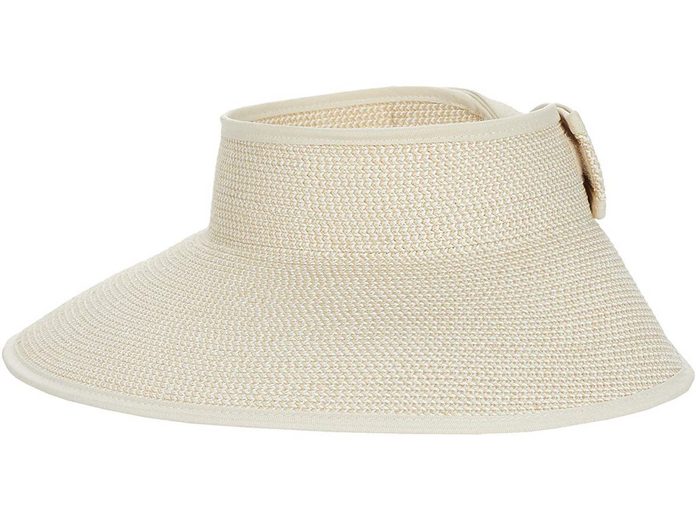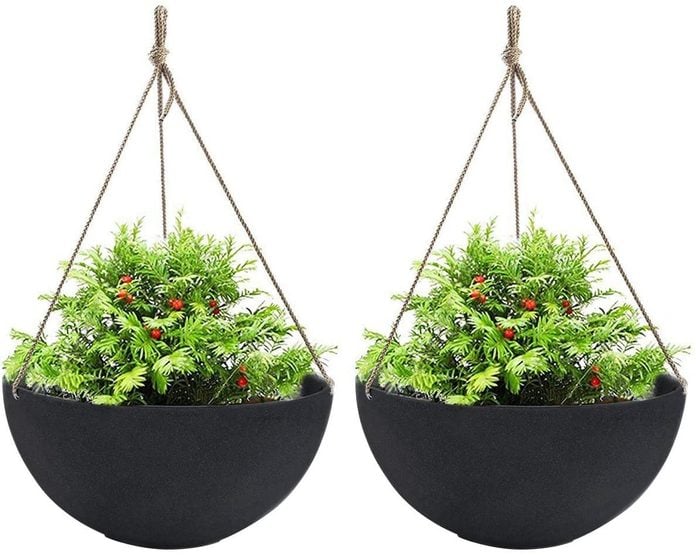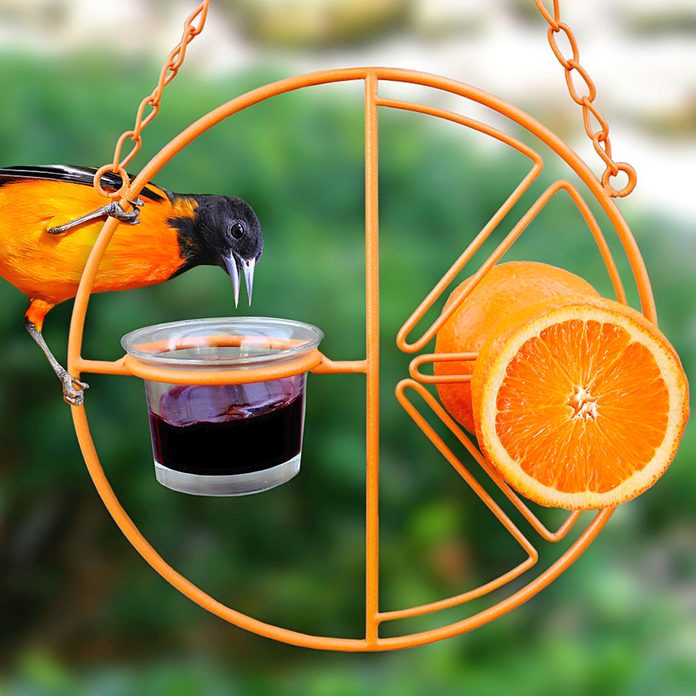If the mom in your life is always in the garden digging in the dirt, growing native plants for backyard butterflies and birds, or watering hanging baskets, the perfect present for Mother’s Day is a garden-themed gift. Here are 22 thoughtful Mother’s Day gardening gifts that will put a smile on her face and help her garden grow. Psst—also check out these bird themed gifts that are perfect for Mother’s Day.

Gardening Mug for Mom
Let mom show off her passion for gardening with this whimsical mug. Pair it with a bag of coffee or her favorite tea and she’ll think of you every time she enjoys a cup.
If Mom loves roses, check out these pretty rose gifts.
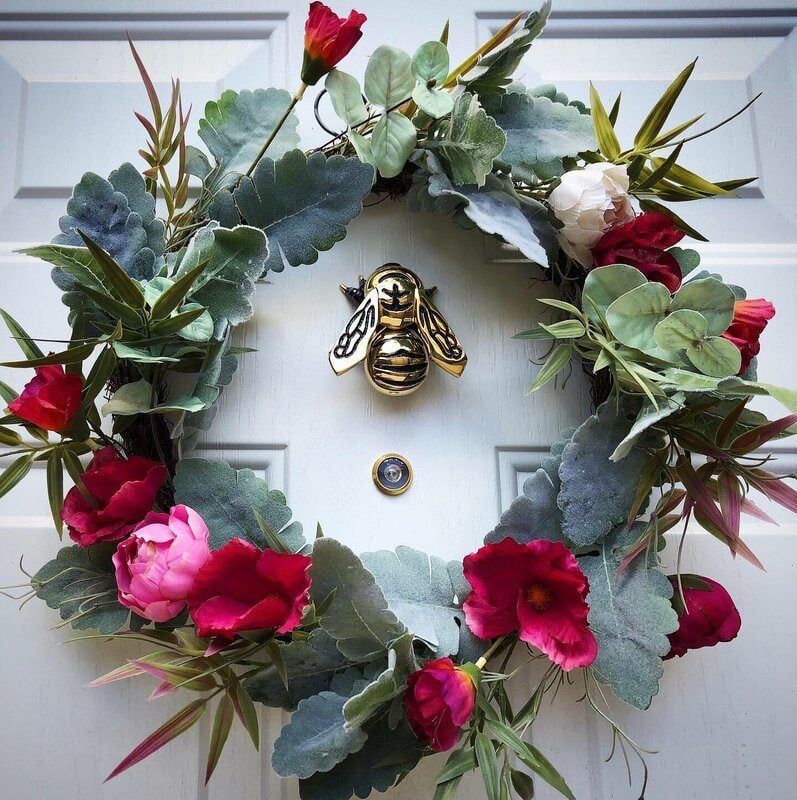
Bee Door Knocker
This adorable bumblebee door knocker will have the neighborhood buzzing! It’s a perfect way for her to show her love of the black and yellow pollinators in her garden. The brass door knocker is available in two sizes — a larger “premium” size as well as a “standard” size — and different finishes including matte black, oiled bronze, nickel silver and brass.
See more bee gifts we can’t stop buzzing about.

Birth Month Flower Candles
Pick a candle that both celebrates your mom and fills a room with the lovely aroma of her birth month’s flowers, even when they’re not blooming outside. This would also be a great gift to celebrate a new mom; choose the month her baby was born. Bonus: Go the extra mile and surprise her with the special meaning behind the birth month flower, too.

Star Shower Garden Art
Add some twinkle to a backyard or garden at night with this solar-powered, battery-operated star shower art. It looks like a lovely watering can with sparking, tiny LED lights. We think this would look amazing illuminating a moon garden or a fairy garden.
Mother’s Day Planters
“Mom, thanks for helping me grow.” How adorable and fun are these Mother’s Day planters? The small pots come in six statement options ranging from cheeky to tear-jerking. Fill them with her favorite succulent or flower and you’ve got a memorable Mother’s Day garden gift she’s sure to love.
Cratejoy Garden Subscription Box
Cratejoy is a hub for subscription boxes for every hobby or interest. You’ll find several options for Mother’s Day garden gift subscription boxes here, including fresh blossoms, succulents, cacti, air plants, seeds, and more. Every month, she’ll get a delivery that includes everything she needs to get gardening (or pretty flowers to admire if she doesn’t have a green thumb).
Bogs Slip-On Garden Shoes
Every gardener needs a pair of slip-on garden shoes that will hold up (and look cute) rain or shine. Bogs slip-on garden shoes are waterproof and have good traction for muddy days. And the colorful rose print? It has Mom’s name all over it.
Personalized Garden Stone
Personalize a small or large decorative garden stone for a thoughtful Mother’s Day garden gift that’s sure to be treasured for years. The garden stones are painted with bees and flowers, then personalized with individual names. This version has space for 21 names if you have a big family. So cute!
Mother’s Day Wind Chime
Whether it’s her first Mother’s Day or her 50th, she’ll adore this beautiful wind chime. The bottom tube paddle can be personalized with a custom message signed with your kids’ or grandkids’ names. Mom will think of you whenever the wind blows!
Hummingbird Stake
If mom really loves hummingbirds, check out the best hummingbird gifts.

Cast Iron Bird Bath
This super-sweet bird bath isn’t just a perfect gift for her — it’s a gift for her backyard birds, too! It stands a little less than 20 inches tall, and it’s made of cast iron, so it’ll continue to provide fresh water for her favorite feathered friends for a good, long while.
Golden Oyster Mushroom Grow Kit
Give Mom some Mother’s Day gardening gifts she can grow AND eat. The golden oyster mushroom grow kit is easy to take care of, and mushroom gardeners have seen growth in as little as a few days. Yum! Check out more of the best mushroom growing kits and logs.
Garden Visor
A good garden visor makes for a fantastic Mother’s Day garden gift. This option by Sunday Afternoons definitely fits the bill. It features a 4 1/4 curved brim to keep the sun out of her eyes, 50+ UPF protection, and an interior grosgrain sweatband. Plus, it’s chic and the adjustable band allows for multiple hairstyles.
Psst—don’t miss more sun hats and visors for gardening from Zappos.
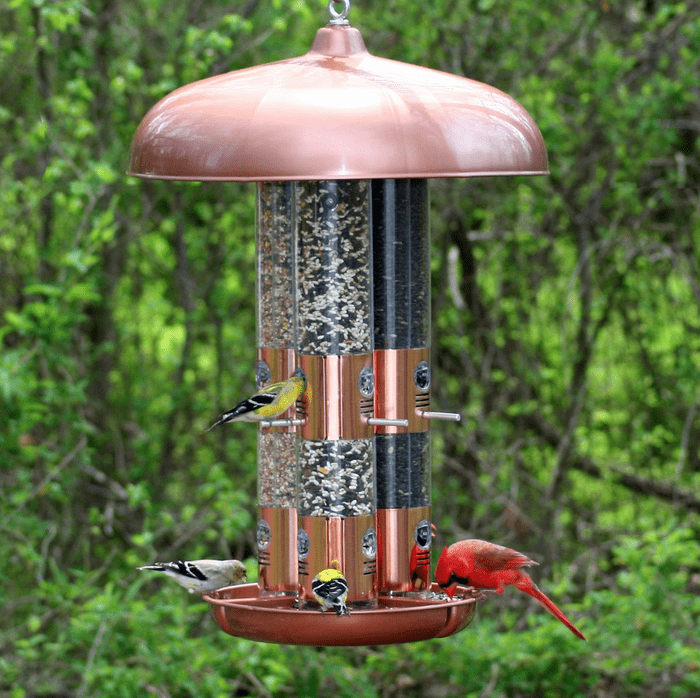
Copper Triple Tube Bird Feeder
This beautiful copper bird feeder has three feeding tubes, so mom can customize bird seed to different birds. This heavy duty feeder can hold up to 10 pounds of seeds, which means mom won’t have to refill it often. Psst—these are the 10 types of bird feeders you need in your backyard.
Set of Two Hanging Planters
Fill these beautiful hanging planters with mom’s favorite flowers and voila: the perfect Mother’s Day gifts for gardening. The chic faux concrete black finish lets the flowers steal the show, and drainage holes and water storage are just smart. Learn how to plant a hanging flower basket in 5 easy steps.
Garden Marker Stakes
Is mom proud of her bountiful herb and veggie garden? She should be! Gift her with these beautiful garden marker stakes that add a touch of organization and class to rows of corn, basil, tomato…or anything she’s growing under the sun. Pair them with a seed storage container for a complete gift.
Personalized Garden Tools
Hand’s off mom’s trowel! One of our favorite Mother’s Day gardening gifts is a nice heavy duty steel garden tool set that includes a trowel and culivating/weeding tool, customized with mom’s name on the handle.
Get ready for Father’s Day, too! Don’t miss perfect gardening gifts for dads.
Waxed Garden Apron
Change mom’s life with a garden apron! It’s made from cool, soft waxed cotton canvas and leather accents. Apron pocket space gives her a second set of “hands” for garden tools, gloves, or stashing her phone while she’s pruning and potting.
Clementine Oriole Feeder
This genius bird feeder draws orioles to mom’s backyard with oranges and jar of grape jelly! Orioles will be attracted to the orange color of the feeder, too.
Birds & Blooms Gardening for Birds, Butterflies and Bees
Our beloved book, Gardening for Birds, Butterflies and Bees, teaches you how to attract birds and other pollinators to your backyard. It’s filled with expert tips and fantastic photos. (Okay, we’re a little biased, but we really do think this book is a great Mother’s Day garden gift!)
Check out more of the top birding and gardening books we love.

Coffee Pot Mesh Bird Feeder
For the mom who loves a cup of morning joe just as much as bird-watching, this coffee pot mesh bird feeder holds 2 lbs. of seed and offers an entertaining new focal point. We love that pretty blue color!
Learn how to choose the best hummingbird feeder.

Backyard Bird Note Cards
Send a fellow bird lover some happy mail with one of these illustrated folding notecards from a pack of eight. Any occasion is the right occasion to share these adorable birds. Mom will enjoy looking for these pretty feathered friends in her yard and garden!
Any bird lover is sure to enjoy bird themed gifts, but they make an especially perfect sweet present for Mother’s Day. Check out these ideas for your mom, grandma, wife, aunt, or any other special mother in your life.
Also don’t miss these Mother’s Day garden gifts your mom will adore.

Mama Bird T-Shirt
If your mom is a mother hen who keeps a close watch on every chick in her flock, she needs this Mama Bird t-shirt. This is one of our favorite bird themed gifts because it looks so cute and comfy!
Here’s why you should pick up Wingspan — the perfect board game for any bird lover.

“This Place is for the Birds” Sign
She can hang this bird sign on the wall to let visitors know who the home is really for! The design is hand painted on lightweight birch and features a jute tassel on top. Check out these bird decor items to feather your nest.

Bird Print Scarf
This delightful handmade scarf features a fun print with cardinals, downy woodpeckers, nuthatches and more. The lightweight fabric means it can be worn year-round, and the seller offers many different bird-themed designs.

Bird Nest Tea Strainer
If she likes to drink tea, give her this smile-inspiring tea strainer. Made of nontoxic, eco-friendly pewter, it rests on top of the cup to “collect leaves in the nest” as the tea steeps.
These redbird gifts are perfect for cardinal lovers.

Birder’s Checklist Mug
This bird themed gift makes recording morning observations all kinds of fun. Using the marker, she can color in the bubble next to the bird’s name and then bake the mug in the oven to immortalize her sightings.
Does your mom love roses? Check out these pretty rose gifts.

Family Flock Necklace
She helped you to fly; acknowledge her unconditional love with this heartwarming personalized necklace. Options from one to nine “fledglings” are available, as are seven different chain lengths.
Psst—you need to see these heartwarming pictures of mother birds with their babies.

Pop-Up Bird Card
The best way to say happy Mother’s Day is with an adorable birdhouse. This card folds down flat for shipping, but when she opens it, it becomes a sweet birdhouse with sparkly flowers. There is space on the bottom of the card to write, too.

Cardinal Tumbler Cup
Get Mom a gift she’ll use again and again with this durable Tervis tumbler cup. Featuring a cute all-around cardinal design, it’s available in 16- and 20-ounce sizes as well as a 16-ounce mug. All options come with a red lid.

Porch Swing Bird Feeder
She’ll love inviting her feathered friends to sit a spell with this whimsical bird feeder, which is handmade to look just like a porch swing. It has a metal mesh bottom for rainwater drainage and hangs from the attached nylon cords. Choose from 8 colors, and you can personalize the feeder with a special message for Mom!
Don’t forget to send mom flowers! We found the best flower (and plant) delivery services.

Hummingbird Socks
If Mom’s a hummingbird fan, she’ll adore these fun hummingbird socks! Colorful hummingbirds appear on the print, zipping through a flower garden against a backdrop of blue skies. You can also choose other animal designs, from giraffes to turtles.

Stone Birdbath
This unique birdbath is a perfect way for Mom to invite even more birds into her yard. Made from a large, hollowed-out and polished stone, it’s available in several sizes and sure to delight everything from backyard fliers to chipmunks and other wildlife.

Hummingbird Jewelry Dish
Mom can store her jewelry (or coins, or keys, or other knick-knacks) in style with this gorgeous dish. Handmade from polymer clay and able to be personalized, it’s a thoughtful and useful gift for any hummingbird fan.

Flower Bluebird Feeder
Bringing in bluebirds is easy with this adorable feeder. With a capacity of 3 ounces, it’s the perfect size for serving mealworms. You could also offer grape jelly to attract orioles. Plus, the blue cup is removable for easy cleaning. (If you like the feeder but not the flower shape, other designs are available — including one in the shape of a heart. Awww!)
Use Close-Focus Optics in the Backyard

If you find yourself looking for the butterflies, bees and dragonflies visiting your flowers, you’re not alone. “You can see interest in pollinators growing exponentially,” says Jaret Daniels, a professor specializing in Lepidoptera research and insect conservation at the University of Florida, Gainesville. “Once people start looking a little closer, a whole new world opens up.” To bring that world into sharper focus, consider a monocular, a loupe, or other close-focus optics.
Check out the birdwatching gear and supplies you never knew you needed.
Use a Loupe for Small Details

Used by entomologists, horticulturalists and backyard naturalists alike, a hand lens, or loupe, is a smaller, more powerful version of a magnifying glass. “We have community science projects where people use them to collect data,” Jaret says.
Best employed in bright daylight, this lens is held close to the eye. Then, the subject is brought toward the eye until it comes into focus. A loupe captures the colors and textures of nonmoving objects such as a found butterfly wing, mushroom gills or a flower petal.
Look for a glass loupe that folds into a closed position to protect the lens and that comes with a lanyard to wear around the neck. Though available in magnifications of 10x to 60x, a 10x lens is typically more than adequate.
Pros: inexpensive, easy to use, small, lightweight
Cons: easy to lose, requires a good light source
Magnify Nature With a Mighty Monocular

With just one viewing tube, a monocular is lightweight and small enough to store in a side pocket while gardening. “It can be used for watching birds at the feeder or in your yard, and for insects that aren’t moving around too much,” Jaret says.
A 6×18 monocular (i.e., with 6x magnification and an 18 mm lens diameter) can focus on objects just a foot away, such as a spider on a leaf. An all-around 8×32 monocular allows you to spot a bird in a distant tree as well as a hummingbird less than 10 feet away. Some 8x magnification monoculars have screw-on close-up lenses that turn them into magnifiers.
Pros: small, compact, cost effective, lightweight
Cons: extended use causes eye fatigue
Capture better images with our ultimate guide to bird photography.
Zero in With Close-Focus Binoculars

Close-focus binoculars generally have lower magnification and a smaller aperture for examining objects as close as 18 inches away. Observe a small moth inside a flower, or see a butterfly using its proboscis.
“You can zoom in pretty close on anything on a plant or just the plant itself,” Jaret says. “It’s ideal for watching dragonflies, damselflies, butterflies and all sorts of pollinating insects.”
Pros: compact, less expensive than birding binoculars
Cons: pricier than a monocular
Next, discover how digiscoping can help you take better nature photos.

For most gardeners, peonies symbolize spring. But thanks to the flower’s long history (dating about 1,400 years back to China’s Tang Dynasty), peonies have gained a variety of meanings across cultures and time periods. So, for example, if you see someone sporting a peony tattoo, where you are in the world may clue you in to what it symbolizes. There are a few common peony meanings, though.
Besides spring, peonies are also associated with weddings and femininity. In the language of flowers or floriography, peonies can mean bashfulness, a happy marriage, love, shame and more. Learn more about peony meaning, symbolism and history.
Learn how to grow and care for peony flowers.
Peony Significance Throughout History

Peonies are a popular choice for gardeners because of their low-maintenance nature and dramatic blossoms. But in China, they’ve been historically bred for more than just their beauty. (One nickname for the tree peony in China is “the king of flowers” where it also represents masculinity.) Traditionally, the roots, bark, seeds and flowers of tree peonies have been used to treat problems like muscle cramps, headaches and dry skin. Peonies are still used in some medicinal practices today.
They appear in Chinese mythology, too. In one tale, an empress is impatient for spring flowers and orders all the nearby flowers to bloom for her. All of the flowers go along with her demands, except the peony. (Peonies are stubborn to this day and blossom in late spring and early summer.) Peonies also frequently appear in traditional Japanese art and poetry to symbolize a righteous spirit and good fortune.
Do peonies need ants to bloom?
Peonies aren’t just an icon in East Asia histories and cultures; they appear in Greek myths, too. One such myth says that Paeon, a student of the god of medicine Asclepius, healed Hades using a peony root. (Hades then transformed Paeon into a peony to protect him from his envious teacher.) Another version featuring Paeon has him easing a woman’s labor pains by using a peony root from Mount Olympus.
Discover even more little-known peony plant facts
Pink Peony Meaning

When most people think peonies, they think pink, and it’s pink peonies that regularly show up in bridal bouquets. Pink peonies symbolize affection, prosperity and a happy marriage. They’re also the flower traditionally given on 12th wedding anniversaries. Go for a classic soft pink hue with ‘Lovely Rose’ or ‘Lady Alexandra Duff’ varieties. Or, if you want to turn up the vibrancy, try ‘Barrington Belle,’ which is more of a fuchsia.
Grow a Sarah Bernhardt peony for garden star power.
White Peony Meaning

If you find yourself needing to apologize to someone, a couple white peonies will help you get the message across. Besides honor and long life, peonies can also represent bashfulness, shyness or even shame. The color white is associated with purity and sympathy. The person who receives your white peonies will know that you mean it when you say “I’m sorry.” The lush ‘Bowl of Cream’ peony variety doesn’t bloom until its second year but the 12-inch double blossoms are worth the wait.
Check out our guide to growing peonies in pots and containers.
Red Peony Meaning
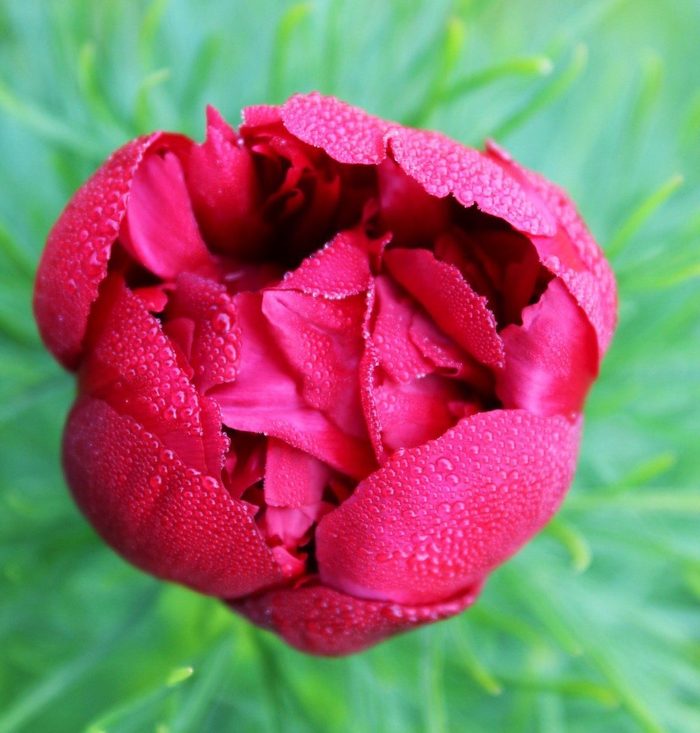
Like many other scarlet-hued blooms, red peonies are associated with passion and love. In China, the color red is also considered lucky. Show your deep affection for someone with a bouquet of red peonies. Or grow some good luck in your own garden. Try planting ‘Henry Bockstoce’ for rich ruby blooms that last about 10 days as cut flowers.
Grow a fernleaf peony for fancy flowers and foliage.
Yellow Peony Meaning

Congratulate someone on a new chapter with a yellow peony or two. Yellow peonies symbolize beginnings, fresh starts and optimism, so they make a perfect baby shower or housewarming gift. For a lovely lemony fragrance, add the bright yellow ‘Garden Treasure’ variety to a sunny spot in your backyard.
Peonies come in even more colors, including purple, orange and multicolored. And there are even more options when it comes to flower types, including single, double, bomb, anemone and more. Explore your local garden center to find a peony variety that’s the perfect fit for your garden.
Next, don’t miss these pretty pictures of peonies in full bloom.
Why You Should Plant a Cutting Garden

Growing a cutting garden is a pretty pastime that saw a significant boost in popularity in the early days of the pandemic—and growing cut-flower gardens is poised to stay. Follow the advice from a Midwest-based master to become a cutting garden pro. Jamie Rohda is the owner of Harvest Home Flowers in Waverly, Nebraska, a farm growing specialty cut-flowers for nearly 25 years.
“A cut-flower garden is not meant for looks but for harvesting,” Jamie says. “Whereas a flower garden meant for the landscape is laid out for the benefit of being viewed, a cut-flower garden’s purpose is to provide the owner with a continuing array of flowers to be harvested and used for floral display.”
That’s not to say a cut-flower garden can’t be aesthetically appealing; it’s just not the primary intent of this type of space. To keep this goal in mind, Jamie finds that it’s best, to situate a cut-flower garden where it is the least visible. The temptation to leave it for viewing is not as great.
Check out the prettiest cutting garden flowers to grow.
Picking Plants for a Cutting Garden
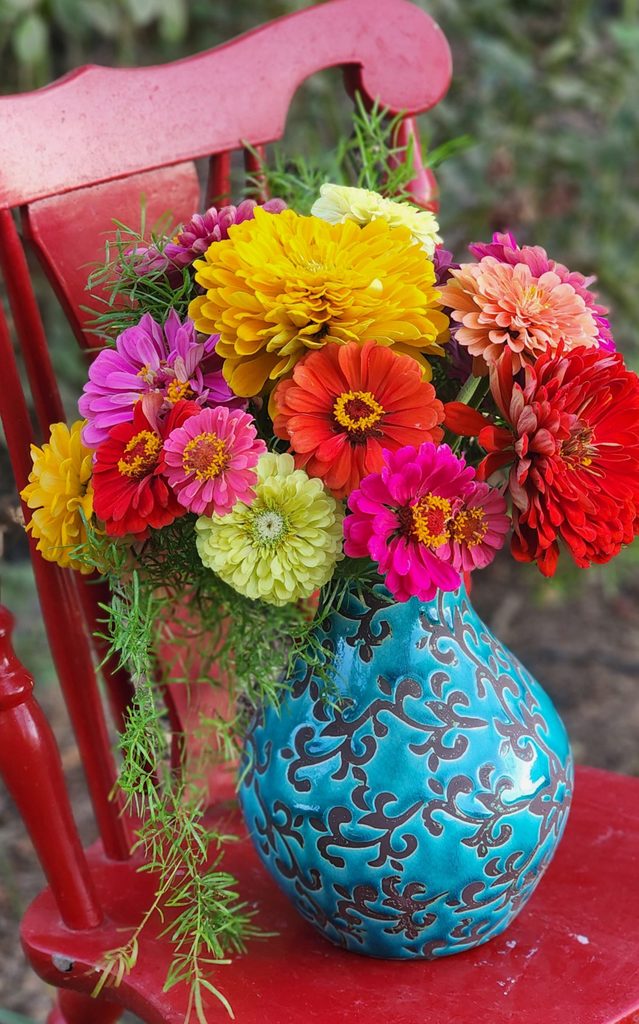
Before choosing flowers for any cutting garden, Jamie suggests that you ask yourself questions to set yourself up for success:
- What amount of sun does the garden get? Will it be best to plant sun-loving flowers, or will this be a partially shaded garden?
- What are your personal likes and dislikes?
- What skills do you have? Is this your first time planting a garden, or do you already have some growing experience?
- How much growing space do you have?
- What climate zone are you in?
Jamie prefers to choose what she calls “cut and come again” blooms, which are “annual types of flowers or flowers that can be planted multiple times throughout the season for the beginning grower, as they give you the most reward for your effort.” Some of her go-to favorites include zinnias, ageratum, tall verbena, sunflowers, celosia, cosmos, gomphrena, dianthus and cut-flower types of marigolds.
Jamie says, “With the addition of some perennials that may already be in the grower’s landscape, these can provide an ongoing array of cut flowers for the entire season.”
Annuals vs. perennials — what is the difference?
Designing a Cutting Garden

In terms of what grows well together, the most important thing to consider is size. “I think as long as the size is considered, almost anything works,” Jamie says. “Of course, you don’t want to grow 5-foot-tall sunflowers in with 18-inch ageratum.”
Sunlight and water availability are the two most important things to consider when designing a cut-flower bed. Jamie says that most easy-to-cut flowers thrive in full or nearly full sunlight, so plan accordingly.
Also, if you live in an area where you need to irrigate, that should be a major consideration during the planning process. She adds one more design note in terms of functionality: “Harvesting is easiest when the garden is laid out in a nice straight bed about 3 feet across.” So aim for that when creating a layout.
Design a gorgeous garden with colorful flowers.
Maintenance Tips for Cutting Gardens

Once you have everything planted, maintenance is crucial, so your hard work doesn’t go to waste. For lifestyle blogger, content creator and avid gardener Kate Knowles of Kate Knowles Home, who started multiple cut-flower gardens from seed in 2021, that means visiting the garden beds almost every morning to check on things.
“Watering is my least favorite chore, so installing a drip irrigation system in our garden beds that waters everything on an automatic timer has made that chore so much easier,” Kate says. “I found a video on YouTube from Garden Answer that shows the exact parts you need and instructions on installing it yourself. It wasn’t too hard to figure out, and our garden benefits from consistent watering.” Kate enjoys maintaining her three cut-flower beds (one dedicated to David Austin roses) with her three sons as a fun family activity.
Check out the top 10 flowers for harvesting seeds.
How to Harvest from Your Cutting Garden

Finally, proper harvesting is essential when working on any cut-flower garden. Jamie suggests planning your flower harvest based on temperature. “In the cool of the morning or evening is the first place to start,” she says. Be sure to have the proper tools.
“A very sharp knife is the best way to harvest cut flowers, but if you’re uncomfortable with that, then a good pair of sharp snips will work,” she says. “Those with a bypass-type blade (not an anvil type) will give you a good clean cut that allows the flower to drink when put in water.” Cut at an angle while harvesting or arranging, Jamie says, as this will expose the most surface area so the stem can draw up water.

Kate likes to keep the seed packets for each flower in her cut garden available, as many contain harvesting instructions for optimal vase life. “Each flower has its own harvesting instructions, and usually it’s best to do it in the mornings when it’s not as hot outside,” she says.
And the best part of a cutting-flower garden? The fresh blooms, of course. The options for using fresh flowers are limitless, but Jamie shares a few favorites. “I personally love just a few stems on my kitchen windowsill to enjoy or a collection of vases with one variety in each vase. Of course, a big mixed bouquet is always great for the dining room table! And having fresh flowers to give to a friend is always delightful for both the giver and the receiver.”
Learn how to arrange fresh-cut blooms from your cutting garden like a pro.
Best Blooms for Cutting Gardens

- Breadseed poppies
- Cosmos
- Dahlias
- David Austin English roses
- Delphiniums
- Iceland poppies
- Marigolds
- Shirley poppies
- Sunflowers
- Sweet peas
- Zinnias
Next, learn how to grow a pollinator garden.
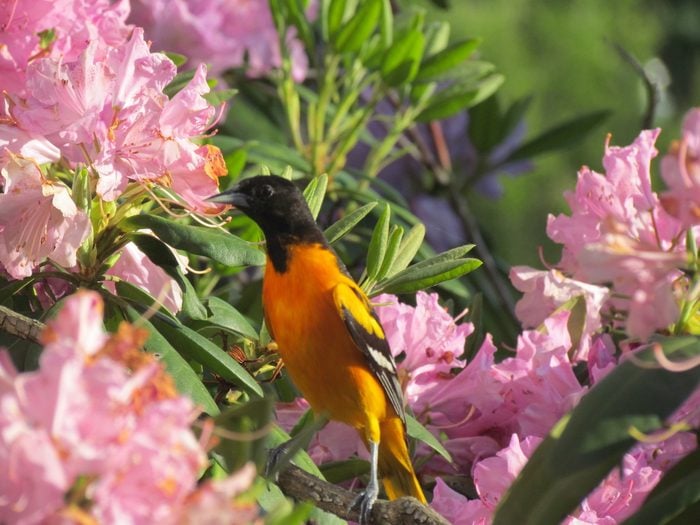
Some plants are just hard to identify—rhododendrons and azaleas definitely fall under this category. They both glow with fresh pink flowers in spring that, on first glance, look very similar to each other. So maybe you bought a mystery plant off of the clearance rack at the garden center or simply lost the plant tag years ago, but you can still make an educated guess. Follow these general guidelines to tell the difference between rhododendron vs azalea.
Add glamour to your yard with Bollywood azalea.
Are Rhododendrons and Azaleas the Same?
The two plants are very closely related. In fact, azaleas are actually part the rhododendron genus. This means all azaleas are technically rhododendrons, but not all rhododendrons are azaleas.
The traits listed below are generalities. While they generally hold true, it’s possible for a rhododendron to display the characteristics of an azalea (and vice versa!). Hybrids and cultivars can be especially tricky to identify.
Check out the top 10 summer flowering shrubs for full sun.
Differences Between Rhododendron and Azalea
How to Identify an Azalea

- Size: Azaleas are usually smaller, with some ground cover varieties only growing 1 to 2 feet tall.
- Foliage: Their pointed and narrow leaves that are sometimes fuzzy. Many species are deciduous, dropping their greenery in the fall.
- Blooms: The flowers tend to be more spread out on stems and more funnel-shaped. They also have less than five stamens, which are the long structures that stick out of the center of the flower.
Azalea Care

To properly care for azaleas, horticultural expert Melinda Myers notes: “Azaleas prefer partial sun and acidic soil that is also moist and drains well. Soggy soil is detrimental to the shallow roots of azaleas. It can be beneficial to cover the surrounding soil with a 2-to-3-inch layer of organic mulch, such as pine straw, composted pine bark or leaves. This helps conserve soil moisture, suppress weeds and insulate the roots from temperature extremes. Just pull the mulch back from the stems to keep them dry.”
Learn how to grow azaleas indoors.
How to Identify a Rhododendron

- Size: Rhododendrons are generally larger flowering bushes, with some growing 20 feet wide.
- Foliage: Most of the leaves are bigger, evergreen and more leathery than the ones that grow on azaleas. Some species have speckles, often called scales, on the underside of leaves.
- Blooms: Look for flowers that are bundled in groups at the end of the stems. They may be bell-shaped and have 10 or more stamens.
Chinese snowball bush vs hydrangea: what’s the difference?
Rhododendron vs Azalea: Get Expert ID Help
When it comes to identifying a rhododendron vs an azalea, it’s never bad to get a second opinion. Try contacting your local cooperative extension office or gardening club for help. They can help you pinpoint your exact plant and offer care tips.
You can also submit your gardening question to Birds & Blooms via our online form. If it is chosen for publication, our garden experts will answer it in an upcoming issue of the magazine.
For more gardening tips, sign up for our free newsletter.
When it’s hot outside, we humans reach for cold drinks, dive into refreshing pools and crank the air conditioning. Hummingbirds, on the other hand, can’t duck indoors when steam’s rising from the pavement. Should you worry about your favorite flying jewels when temperatures rise? We consulted John Shewey, author of The Hummingbird Handbook, to learn how hummingbirds adapt to hot weather. He also discusses how you can help these tiny fliers when temperatures climb.
How do hummingbirds survive snow and cold weather?
How Do Hummingbirds Tolerate Heat?
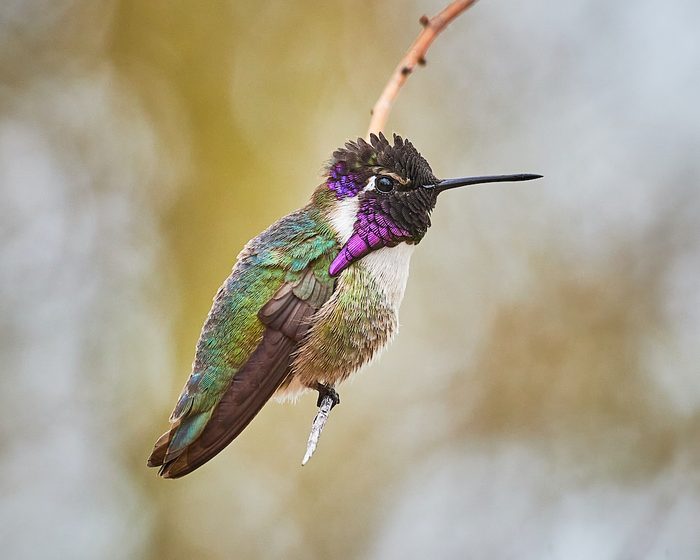
These tiny birds are better adapted to hot weather than you’d think. After all, most members of the hummingbird family live in the tropics. John says heat exhaustion for a hummer is possible in theory, but they’ll seek out shelter from heat much as humans do.
“Given shade and moisture, hummingbirds can tolerate plenty of heat,” John explains. “Some species in fact, like the Costa’s hummingbird of the Southwest, are well-adapted to heat.” He also mentions that hummingbirds have areas of low feather density around their legs, eyes, and the bases of their wings. These features of their anatomy help them shed any excessive warmth during flight.
Where do hummingbirds sleep at night?
How Can You Help Hummingbirds in Hot Weather?

That doesn’t mean hummingbirds don’t need help on sweltering days. John points out that in many places, summertime temperatures are gradually increasing. Humans, he says, are agents of extreme habitat alteration. What does that mean? John gives an example: “A nicely mowed lawn and manicured yard looks nice, but it’s a severe departure from a natural habitat.”
Create Shady Spots for Birds to Rest and Cool Down
If you want to help these gorgeous birds, consider planting hummingbird plants that thrive in shade, and providing plenty of shade in your yard, in general.
How Often Should You Change Hummingbird Food in Summer?
It’s especially important to pay attention to your hummingbird feeders during hot weather. Sugar water spoils faster when temperatures heat up. Those who enjoy feeding hummingbirds need to be aware of when they last changed the nectar.

“The single most important thing we can do for hummingbirds during any weather is to never allow our sugar water to start going bad,” John says. “When the temperature outside hits 80 (degrees), change out sugar water every day. Above 90, and especially above 100, provide fresh nectar twice or even three times a day.” He also recommends scrubbing feeders with hot water and rinsing them thoroughly before refilling.
To help keep the nectar fresh a little longer, keep the feeders out of full sunlight during the hottest part of the day. That doesn’t necessarily mean burying them in deep shade, where hummers might not see them; dappled light and shade may work best.
Add a Water Feature
Hummingbirds also enjoy bird baths. John says adding a mister to your yard is a great way to give them the chance to take a delightful shower. “You can even ‘train’ hummingbirds to anticipate a good mist by using a mister with a timer that turns on the mist at the same time every day,” John says.
To learn more, check out The Hummingbird Handbook: Everything You Need to Know About These Fascinating Birds, published by Timber Press.
Next, learn how to keep your yard safe from hummingbird predators.
On This Page
Types of Peonies to Grow
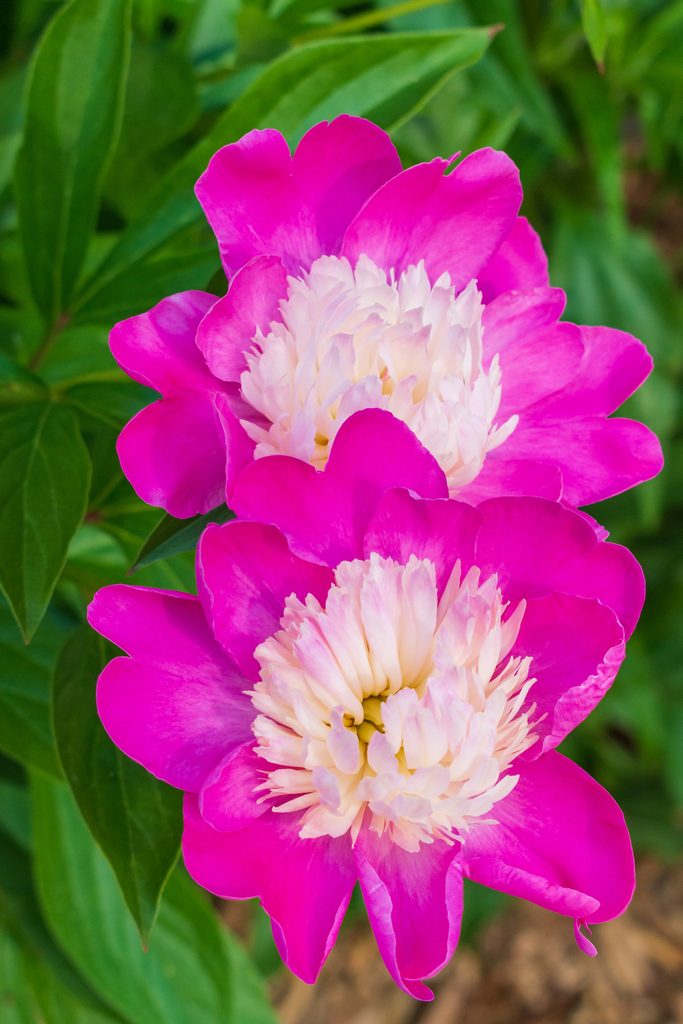
With an undeniable, in-your-face appeal of opulent blooms, peonies are among the easiest perennials to grow. Grown well, peonies can delight you – and future generations – for more than 100 years. With so many varieties hitting the market, how to choose the right types of peonies for you? Here’s what you need to know.
“Right now, peonies are going through a renaissance of popularity,” says Nate Bremmer, President of the American Peony Society and owner of Solaris Farms in Wisconsin. Social media wedding pictures spiked interest, but we are also seeing an explosion of new hybrids that weren’t available to our grandparents, Bremmer says.
There are three main types of peonies on the market: herbaceous, woody, and Itoh/intersectional peonies. Requiring a chilling period to thrive and bloom, most are zoned for USDA hardiness Zones 3 through 7, and a few for Zone 8. Each plant may bloom only 2-to-4 weeks, but picking a succession of varieties can deliver two months of unforgettable blooms.
Learn how to grow and care for peony flowers. While you’re at it, also learn about the meaning behind peony flowers.
Herbaceous Peonies

The most prevalent group, herbaceous peonies grow from spring through fall, dying back and going dormant in the winter. The flowers are so abundant and heavy, they may require support from stakes and twine or hoops.
Popular with florists, the majority of these are cultivars of the Chinese peony, Paeonia lactiflora, which often grants them a sweet fragrance and strong stems for cutting. Newer, more complex hybrids are adding variety in habit, flower shapes and colors to the mix. Some of these don’t need to be staked, so they are worth seeking out from specialty retailers. Bremmer is a fan of award-winner ‘Etched Salmon.’
See 6 gorgeous peony colors to grow.
Woody Peonies

Rather than “tree peonies,” the American Peony Society prefers to call these “woody peonies”. They lose their leaves but retain their woody stems year-round, offering border structure through the colder months, though not quite reaching “tree” size. They range in hardiness from Zones 4b to 8, but Bremmer says APS members grow them with protection even in Zone 2.
“Woody peonies have gorgeous otherworldly flowers,” up to nine inches wide, and “wonderful foliage” says Bremmer. Because it can grow multiple blooms on each stem a mature plant can sport hundreds of flowers. “They often make very nice landscape plants even when out of bloom,” he says. As a bonus, some offer red fall color before leaf drop.
Learn 10 little-known peony plant facts.
Itoh/Intersectional Peonies

These are crosses between herbaceous and woody peonies, blending the habit of herbaceous types with the woody types’ abundant flowers. Though the words are often used interchangeably, Itohs employ P. lactiflora, while rarely seen Intersectional peonies use other species. Itohs deliver the brightest yellows available, like ‘Bartzella’ and ‘Garden Treasure’.
They take years to develop and cannot be grown from seed, leading to high price tags, especially when introduced. These are the longest-blooming peonies, with a bloom cycle lasting up to four weeks. You may see 50 flowers on an Itoh plant, says Laura Root, Merchant/Category Manager for Live Plants at Jackson & Perkins.
Don’t miss these pretty pictures of peonies in full bloom.
Guide to Peony Flower Shapes

Peonies come in a world of shapes. Mix and match them for eye-catching bouquets and borders.
Here’s how Laura Root describes them:
- Single – five or more guard petals with showy stamens, with a flat or cupped shape
- Anemone – cluster of stamens, usually yellow surrounded by flat open petals
- Japanese – visible stamens with more layers of ruffled petals
- Semi-Double – a traditional look, even more layered with a central cluster of petals; stamens may peek out
- Double – two or more rows of petals obscure the stamens – a distinct dome shape with a flat base
- Bomb – a large dome with a cluster of one or more rows of slightly smaller petals. One of her favorites is ‘Sorbet,’ with a two-toned effect in sunset hues.
Note that the easier it is to reach the stamens, the better pollinators like the flower, so singles, Japanese, and Anemone types of peonies will best feed the bees.
Do peonies need ants to bloom?
Secrets for Growing Happy Peonies

Location
Full sun to partial shade away from late afternoon sun and high winds. While they can handle mild-mannered, shallow-rooted neighbors like annuals and succulents, allow plenty of elbow room between more robust plants, including your grassy lawn.
Here are some beautiful peony arrangements and gifts you can send out this spring.
Planting

Plant in well-drained neutral soil in late summer or fall. Place herbaceous and Intersectional types with eyes facing up two to three inches underground and woody peonies, typically grafted, at least four inches below ground. Mulch lightly the first year.
Fertilizer and Water
Peonies resent coddling, says Bremmer. For most, water well at planting, and in May and June as buds are forming, with a lighter touch on woody types. Go easy on fertilizing, using balanced gentle formulas, and avoiding high nitrogen mixes. Bulb fertilizer is a good choice after flowering.
Pruning

Remove all dead foliage after frost for herbaceous and intersectional peonies. For woody types, simply prune dead, crowded, or broken branches as new growth emerges in spring.
Next, check out the guide to growing peonies in pots and containers.

Peonies are a carefree favorite in the perennial garden, where they grow into large flowering masses. But if you don’t have the yard space, you can grow peonies in pots instead, as long as you’re willing to give them a little more care.
Learn how to grow and care for peony flowers.
Where Can You Grow Peonies in Pots?
When planted in the ground, peonies usually thrive in zones 3 to 8. Growing these flowering shrubs in pots can be a little more difficult in the colder zones, because pots don’t provide as much protection from plunging winter temps. As long as you’re willing to take steps to overwinter them properly, though, their container growing range is about the same.
See how plant zones work and find yours.
Choose the Right Container for Peonies

Peonies have deep tap roots, and their branch roots like to spread out wide. They don’t like to be moved once they’re established, so put them into a nice big pot right from the start. Choose one that’s at least 20 inches wide and deep, and avoid terracotta as it can dry out too quickly.
Make sure the pot has adequate drainage holes. Peony tubers will rot if they sit in soggy potting soil, so your pot needs to allow excess water to escape freely.
Discover 10 little-known peony plant facts.
Plant Peonies in Pots Properly
Once you’ve got the right container, you’re ready to plant. Fill the pot with a potting soil mix that provides good drainage. If the soil doesn’t contain fertilizers, add a healthy mix of compost to the soil.
Take care to plant your peonies at the proper depth; planting them too deep can reduce flowering. If you’re planting a bare root tuber, position it with the eyes facing up, and bury it no deeper than 2 inches or so. For peony plants, ensure the crown of the plant is level with the top of the soil, just slightly below the rim of the container. The best time to plant peonies is fall.
Many peonies require support for their heavy flower heads. Tomato-cage supports can be ideal in pots. Add them when you plant, so your peonies will fill in and hide them over time.
Don’t miss these pretty pictures of peonies in full bloom.
Find the Right Spot

Peonies like lots of sun, at least 6 hours each day. A little afternoon shade is OK, and may extend the life of your blooms. Be sure to protect your plant from high winds and heavy rains, which can easily topple them.
Do peonies need ants to bloom?
Watering Your Potted Peonies
Peonies like evenly moist soil, but absolutely hate sitting in soggy spots. While ground-planted peonies can use their deep tap roots to seek out moisture even in a drought, potted specimens will need regular watering. Check the soil every few days, and when the top couple of inches are dry, water them until excess runs out of the bottom of the pot.
Add these gorgeous peony colors to your garden.
Overwintering Peonies in Pots
Cut the foliage back to the base in late fall, when leaves begin to yellow and drop off. Removing all the foliage from the pot can help prevent peony wilt disease.
Add a heavy layer of mulch overtop, and move the pot to a sheltered area (a garage or potting shed is ideal) until warm weather returns. In the spring, watch for red shoots to appear as the weather warms up. Now you’re ready to move your peony back outdoors!
Elegant Sarah Bernhardt peony will be a garden star in your yard.
Avoid Peony Pests and Diseases
In general, peonies aren’t susceptible to too many issues. Peony wilt disease is a fungus that shows up in early spring, causing shoots and buds to wither and turn brown. In this case, your only option is to remove the affected foliage and see if the plant can recover.
Learn how to treat botrytis blight in peonies.
Best Peony Varieties for Growing in Pots

These smaller, sturdier peony varieties can make terrific container plants.
- Paeonia ‘Oslo’
- P. ‘Kiev’
- P. ‘Dublin’
- P. ‘Border charm’
- P. ‘Bartzella’
- P. ‘Magical Mystery Tour’
Grow a fernleaf peony for fancy flowers and foliage.







